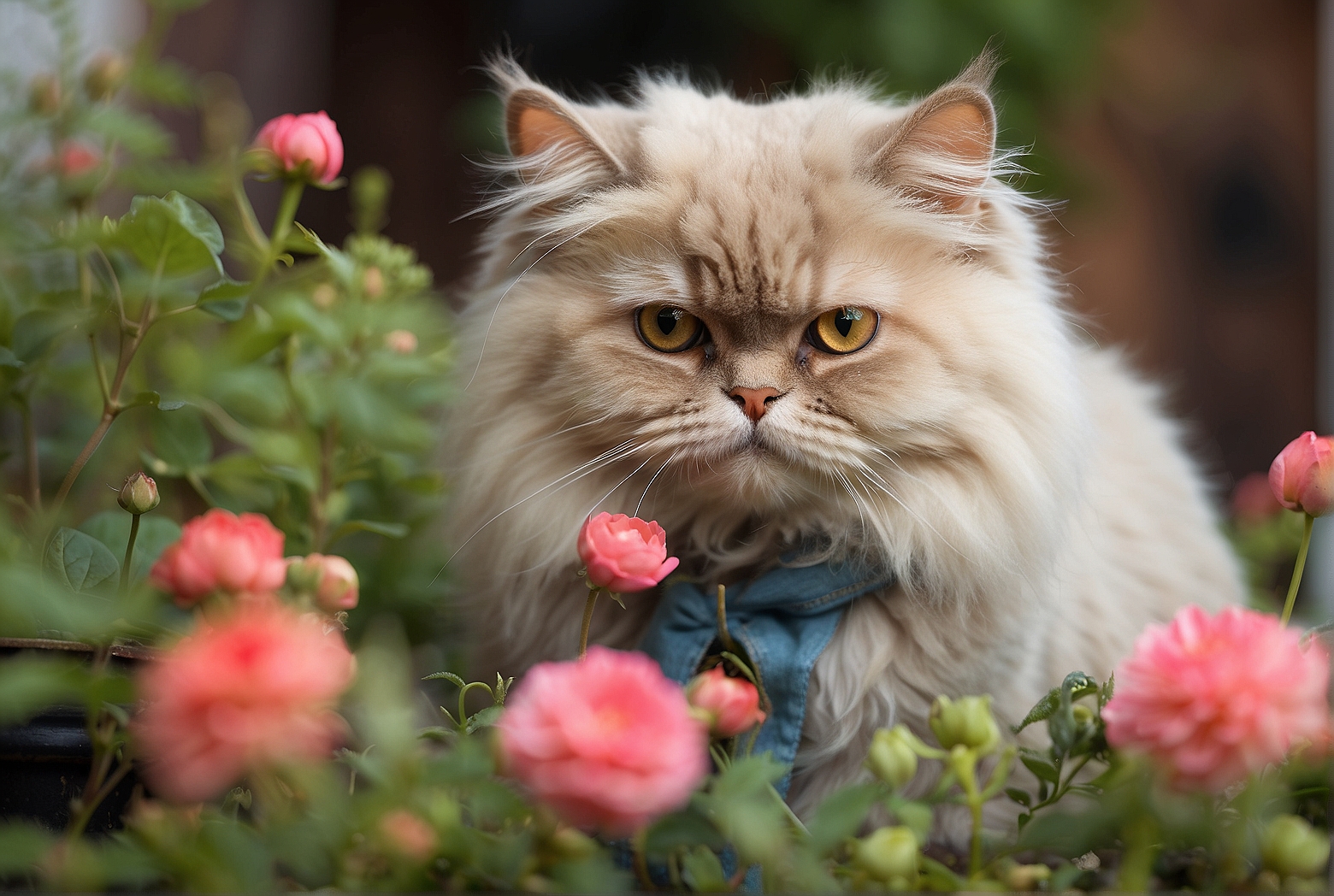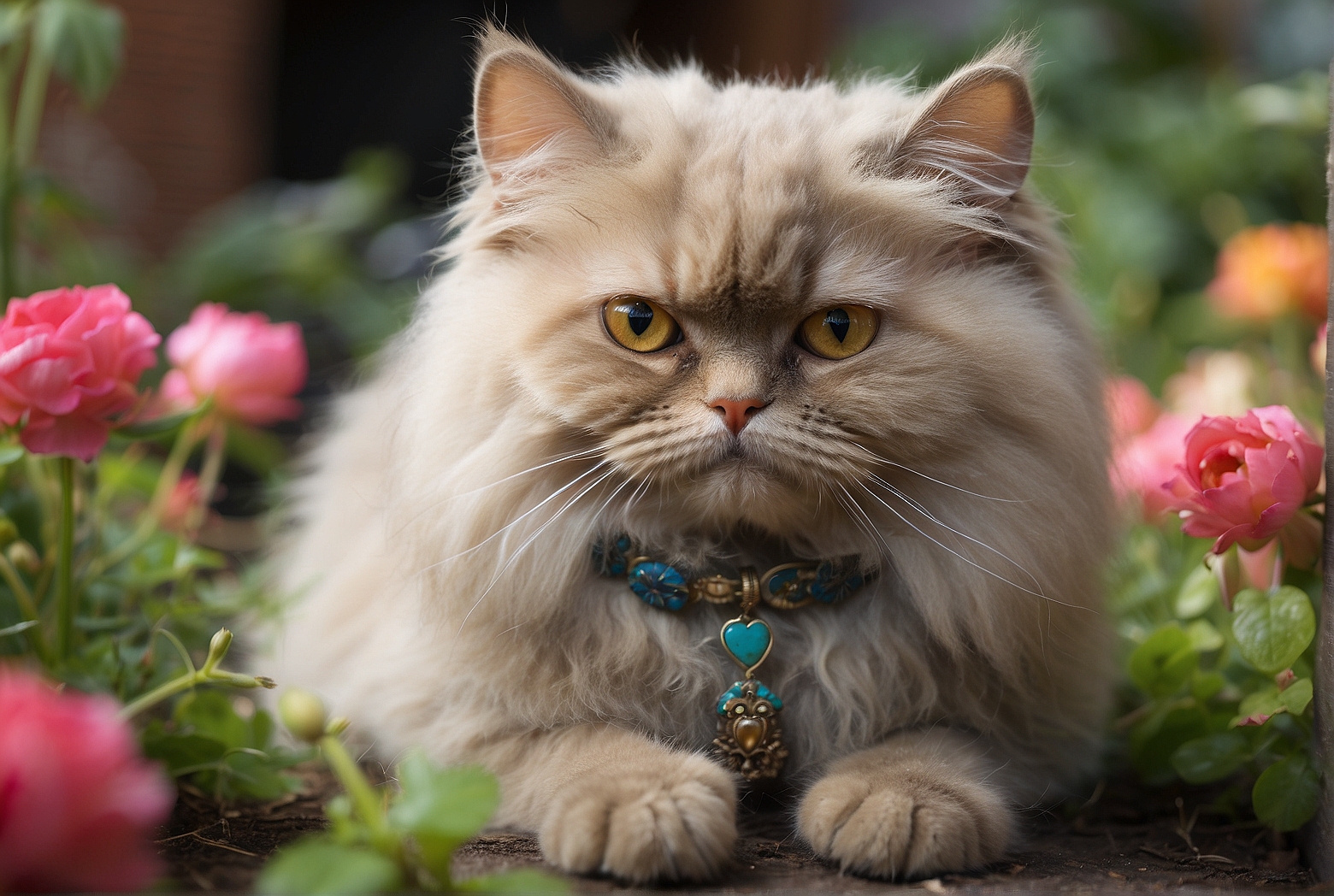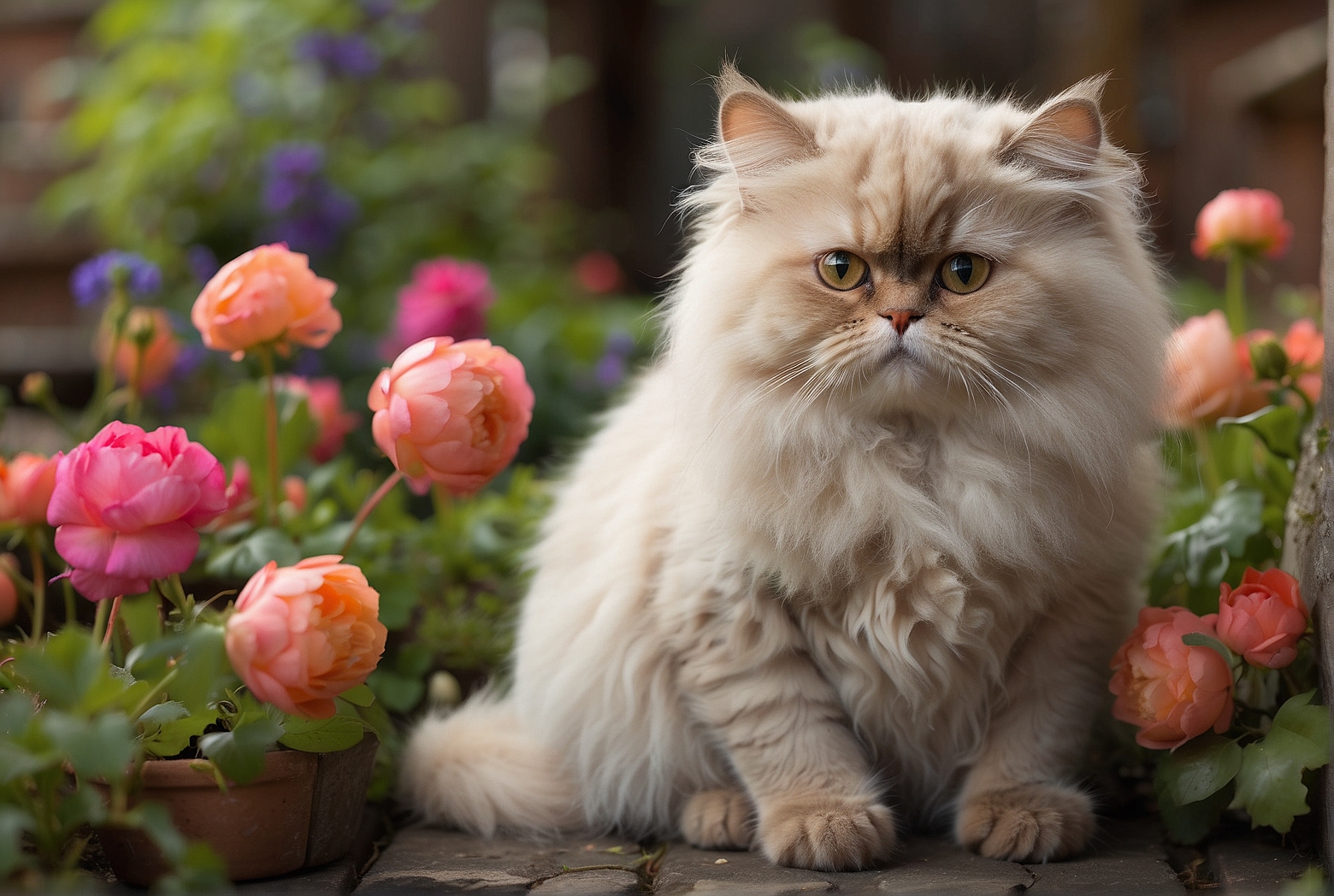Let’s talk about our furry friends, the Persian cats, and their adventures in the garden! Whether you own a Persian cat or simply appreciate their beauty, you may wonder if these regal felines can enjoy some outdoor time in the garden. In this article, we’ll explore the fascinating world of Persian cats and how they fare in the great outdoors. So, grab a cup of tea and let’s discover if Persian cats can join you for a stroll in the garden!
Creating a Safe Garden Space for Persian Cats
Fence and Gate Considerations
To create a safe garden space for your Persian cats, it’s important to consider the fence and gate. Persian cats are known for their curiosity, and they may try to explore beyond the boundaries of your garden. Ensure that the fence surrounding the garden is high enough to prevent them from jumping over it. Additionally, make sure that the gate is secure and cannot be easily opened by your cats. This will help prevent them from accidentally escaping or encountering potential dangers outside the garden.
Plant Selection
When designing a garden space for Persian cats, it’s crucial to be mindful of the plants you choose. Some plants can be toxic to cats and can cause serious harm if ingested. Research cat-friendly plants and avoid ones that are known to be toxic to felines. Opt for non-toxic plants such as catnip, cat grass, and certain varieties of herbs like mint and parsley. These will not only be safe for your Persian cats to be around but can also provide them with some enrichment and stimulation.
Creating a Shaded Area
Persian cats are known for their luxurious fur which can make them more sensitive to heat and sunlight. To create a comfortable garden space for them, make sure to provide a shaded area where they can seek shelter from direct sunlight. This can be achieved by strategically placing umbrellas, canopy tents, or creating a shaded structure using plants or other materials. Offering a cool and shaded spot will ensure that your Persian cats can enjoy the garden without overheating.
Hazard-Free Environment
To ensure the safety of your Persian cats, it’s crucial to create a hazard-free environment. Remove any potentially dangerous objects or chemicals that your cats might come into contact with. Secure loose wires, sharp objects, and toxic substances such as pesticides, fertilizers, and cleaning products. Regularly inspect the garden for any potential hazards and address them promptly to prevent accidents or injuries to your furry friends.
Avoiding Toxic Substances
In addition to creating a hazard-free environment, it’s essential to be cautious of potential toxic substances in the garden. Some common garden plants, including lilies, tulips, and azaleas, can be toxic to cats if ingested. Take the time to familiarize yourself with plants that are toxic to felines and avoid planting them in your garden. If you have existing toxic plants, consider removing them or keeping them in areas that are inaccessible to your Persian cats. Regularly check for any fallen or chewed plant parts to ensure they haven’t ingested anything harmful.

Training and Supervising Persian Cats in the Garden
Start with Indoor Training
Before allowing your Persian cats in the garden, it’s important to start with indoor training. Teach them basic commands and establish boundaries within your home. This will help them understand and respect your instructions when they are outdoors. Use positive reinforcement techniques such as treats and praise to encourage desired behaviors and discourage unwanted ones. This will lay the foundation for a successful transition to outdoor training.
Gradual Exposure to the Outdoors
Once your Persian cats have successfully completed indoor training, you can begin gradually exposing them to the outdoors. Start by allowing them supervised access to a small enclosed section of the garden. This will allow them to become familiar with the new environment and adjust at their own pace. As they become more comfortable, gradually increase their access to the rest of the garden. By taking it slowly, you can ensure that they feel safe and confident in their new outdoor space.
Supervise and Monitor Activities
While allowing your Persian cats in the garden, it’s important to supervise and monitor their activities. Keep a close eye on them to ensure they don’t encounter any potential dangers or escape routes. If there are specific areas of the garden that you want to restrict access to, use physical barriers or deterrents like plants or fences. Regularly check for any signs of distress or discomfort and address any issues promptly. By providing constant supervision, you can ensure a safe and enjoyable experience for your Persian cats in the garden.
Use Positive Reinforcement
Positive reinforcement is an effective training technique when it comes to training Persian cats in the garden. Reward desired behaviors, such as staying within designated boundaries or using a designated toileting area, with treats, praise, or playtime. This will motivate your cats to repeat these behaviors and reinforce the training. Avoid using punishment or negative reinforcement as it can cause stress and anxiety in your cats, which may hinder their progress. By focusing on positive reinforcement, you can create a positive association with the garden and encourage good behavior.
Setting Boundaries
Setting clear boundaries is essential when training Persian cats in the garden. Define specific areas that are off-limits to your cats, such as areas with toxic plants or potential hazards. Use visual cues, such as fencing or raised flower beds, to clearly mark these boundaries. Reinforce these boundaries during your training sessions by redirecting your cats away from restricted areas and towards safe zones. With consistent training and reinforcement, your Persian cats will learn to respect these boundaries and enjoy the garden within the designated areas.
Benefits of Allowing Persian Cats in the Garden
Stimulation and Enrichment
allowing Persian cats in the garden provides them with a plethora of stimulation and enrichment opportunities. They can engage their senses by exploring different textures, scents, and sights in the outdoor environment. The garden offers an ever-changing landscape for them to discover, which can help alleviate boredom and provide mental stimulation. From rustling leaves to chirping birds, the garden is an exciting playground that can keep your Persian cats entertained and engaged.

Health and Exercise
The garden offers Persian cats the opportunity to engage in physical activity, which is vital for their overall health and well-being. They can indulge in playful pouncing, chasing insects, or climbing trees, all of which promote exercise and help them maintain a healthy weight. Regular exercise in the garden can also contribute to muscle development, joint flexibility, and cardiovascular health. Allowing your Persian cats to enjoy the garden can help prevent obesity-related health issues and ensure they lead a happy and active life.
Sense of Independence
Persian cats are known for their independent nature, and the garden can provide them with a sense of freedom and autonomy. They can explore and navigate the outdoor space at their own pace, satisfying their natural curiosity and desire for exploration. The garden allows them the independence to engage in various activities without constantly relying on human interaction. This sense of independence can contribute to their overall happiness and well-being.
Bonding with Nature
Permitting Persian cats in the garden allows them to establish a deeper connection with nature. They can experience the sights, sounds, and smells of the natural world, fostering a sense of harmony and tranquility. This connection to nature can have a calming effect on your cats, reducing stress and anxiety. Whether it’s lounging under a tree or watching butterflies flutter by, the garden provides your Persian cats with opportunities to relax and appreciate the beauty of the outdoors.
Risks and Precautions
Predators and Other Animals
When allowing Persian cats in the garden, it’s crucial to be aware of potential predators and other animals that may pose a threat. Some common predators include birds of prey, foxes, or stray dogs and cats. Ensure that your garden has adequate fencing or barriers to prevent other animals from entering and posing a danger to your Persian cats. Avoid leaving food outside, as it may attract unwanted visitors. Regularly inspect the garden for any signs of predators and take necessary precautions to keep your cats safe.
Escape Routes
Persian cats are naturally curious and may attempt to explore beyond the boundaries of the garden. It’s essential to identify and eliminate any potential escape routes. Regularly check the perimeter of the garden for gaps in fencing or holes that your cats may have created. Reinforce any weak spots to prevent them from escaping. Additionally, ensure that the gate is secure and cannot be easily pushed open. Taking these measures will help minimize the risk of your cats wandering off and getting lost or encountering danger.
Disease and Parasite Control
The garden can be a breeding ground for various diseases and parasites, so it’s crucial to take preventative measures to protect your Persian cats. Ensure that your cats are up-to-date on their vaccinations and take them for regular veterinary check-ups. Keep the garden clean and free from any stagnant water, which can attract mosquitoes and other disease-carrying insects. Use appropriate flea and tick prevention measures recommended by your veterinarian. Regularly inspect your cats for any signs of parasites and address them promptly to avoid any health issues.
Poisonous Plants
Some garden plants can be toxic to cats if ingested. Take the time to research and identify any plants in your garden that may pose a potential threat. Remove or relocate any toxic plants to areas that are inaccessible to your Persian cats. Consider planting cat-friendly alternatives such as catnip, cat grass, or catmint. Be vigilant and regularly check for any signs of chewing or ingestion of plant material. If you suspect your cat has ingested something poisonous, contact your veterinarian immediately.
Traffic and Road Safety
Gardens located near roads or high traffic areas can pose a significant risk to Persian cats. The proximity to traffic increases the chances of accidents, such as being hit by a car. If your garden is located near a road, consider using additional fencing or hedges to create a barrier between the garden and the road. This will help minimize the risk of your cats straying onto the road and encountering danger. Always supervise your cats when they are in the garden and avoid leaving them unsupervised near areas with potential road access.
Alternatives to Allowing Persian Cats in the Garden
Indoor Enrichment Options
If you are unable to allow your Persian cats in the garden or prefer to keep them indoors, there are various indoor enrichment options available. Invest in interactive toys, scratching posts, and climbing trees to provide mental and physical stimulation. Create designated play areas within your home where your cats can engage in activities. Rotate toys regularly to keep their interest piqued. Additionally, spend quality time playing and interacting with your cats to ensure they receive the necessary mental and physical stimulation.
Catios and Enclosures
Catios, also known as cat patios, are an excellent option for creating an outdoor space for your Persian cats while ensuring their safety. These are enclosed structures that allow your cats to experience the outdoors while remaining protected from potential dangers. Catios can be attached to a window or designed as standalone structures in your garden. They can be customized with perches, shelves, climbing structures, and plants to create an enriching environment for your cats. Catios provide a compromise between indoor and outdoor life and allow your Persian cats to experience the sights and sounds of the natural world.
Creating a Sunroom or Conservatory
Another alternative to allowing Persian cats in the garden is to create a sunroom or conservatory. This enclosed space allows your cats to bask in the sunlight and enjoy the benefits of the outdoors while staying protected indoors. Create a comfortable environment by providing perches, scratching posts, and interactive toys. You can also incorporate plants that are safe for your cats to enhance the sensory experience. A sunroom or conservatory provides a safe and controlled environment for your cats to enjoy the outdoors without the risks associated with the garden.
Indoor Plants for Stimulation
Bring a piece of the outdoors inside by incorporating safe and cat-friendly indoor plants. This provides your Persian cats with a stimulating environment with the benefits of nature. Choose plants that are non-toxic and safe for cats, such as spider plants, Boston ferns, or cat grass. Indoor plants offer opportunities for exploring different textures and scents, mimicking the sensory experiences of the outdoors. Be sure to research the specific needs of each plant and make adjustments accordingly. Indoor plants can provide visual appeal and mental stimulation for your Persian cats within the confines of your home.
Creating a safe and enjoyable garden space for your Persian cats requires careful consideration, training, and supervision. By taking the necessary precautions and providing the right environment, you can ensure that your Persian cats can experience the joys of the outdoors while remaining safe and protected. Whether you choose to allow them in the garden or explore alternative options, the well-being and happiness of your furry friends should always be the top priority.
